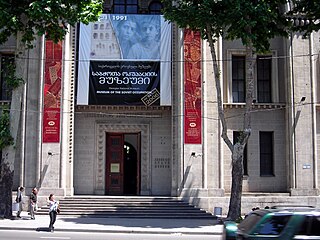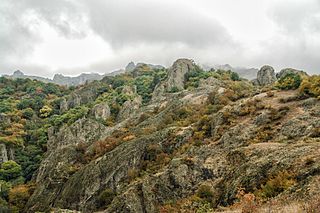
Monument historique is a designation given to some national heritage sites in France. It may also refer to the state procedure in France by which national heritage protection is extended to a building, a specific part of a building, a collection of buildings, a garden, a bridge, or other structure, because of their importance to France's architectural and historical cultural heritage. Both public and privately owned structures may be listed in this way, as well as movable objects. As of 2012, there were 44,236 monuments listed.

The Gialia Monastery is the ruined medieval Georgian Orthodox monastery at the village of Gialia, Paphos District, northwest Cyprus. The monastery is dedicated to the Virgin Mary.

The Georgian National Museum unifies several leading museums in Georgia. The museum was established within the framework of structural, institutional, and legal reforms aimed at modernizing the management of the institutions united within this network, and at coordinating research and educational activities. Since its formation on December 30, 2004, the Museum has been directed by professor David Lordkipanidze.

Gremi is a 16th-century architectural monument – the royal citadel and the Church of the Archangels – in Kakheti, Georgia. The complex is what has survived from the once flourishing town of Gremi and is located southwest of the present-day village of the same name in the Kvareli district, 115 kilometers east of Tbilisi, capital of Georgia.

Tsageri is a town in Georgia, located in Racha-Lechkhumi and Kvemo Svaneti region in the west of the country and serving as an administrative center of the homonymous district.

Chkhorotsqu is a townlet in western Georgia, located in the region of Samegrelo-Zemo Svaneti and functioning as the administrative center of the homonymous district. Its population was 3,141 as of 2014.

The current legislation regarding historical monuments in Spain dates from 1985. However, Monumentos nacionales were first designated in the nineteenth century. It was a fairly broad category for national heritage sites protecting, for example, the Alhambra. The overarching category for Spanish heritage sites is now Bien de Interés Cultural.
Immovable Cultural Heritage of Exceptional Importance are those objects of Immovable cultural heritage that enjoy the highest level of state protection in the Republic of Serbia. Immovable Cultural Heritage is classified as being of Exceptional Importance upon decision by the National Assembly of Serbia. They are inscribed in the Central Register of Immovable cultural property maintained by the Institute for the Protection of Cultural Monuments of Serbia. Objects of Immovable cultural heritage have to fulfill one or more of those criteria defined in the Law on Cultural Heritage of 1994 in order to be categorized as being "of exceptional importance":
- exceptional importance for social, historical or cultural development of the people, or for the development of its natural environment;
- evidence of important historic events or persons and their work;
- unique (rare) example of human creativity of the time or a unique example from the natural history;
- great influence on the development of society, culture, technology, or science;
- exceptional artistic or aesthetic value.
Georgia has a long history of establishing protected areas dating back to 1912 when the Lagodekhi Strict Nature Reserve was created. Nowadays, protected areas make up to 7% of the country's territory and about 75% of protected areas are covered by forests. Total number of protected areas in Georgia — 89. In Georgia there are 14 Strict Nature Reserves, 12 National Parks, 20 Managed Nature Reserves, 40 Natural Monuments, 2 Ramsar sites and 1 Protected Landscape. Management and coordination of the Protected Areas is implemented by a Legal Entity of Public Law Protected Areas Agency of the Ministry of Environment Protection and Natural Resources of Georgia. Currently under development:

The Ministry of Sport & Youth Affairs of Georgia was a governmental agency within the Cabinet of Georgia in charge of regulating activities related to sports and youth development in Georgia. In December 2017 the ministry was merged with that of Culture to form the Ministry of Culture and Sport.

The Ministry of Culture, Sport and Youth of Georgia is a governmental agency within the Cabinet of Georgia. It is in charge of regulating activities related to preservation of Georgian culture and its cultural monuments as well as activities related to sports and youth development.

The National Institute of Cultural Heritage of Poland is a Polish governmental institution responsible for documenting cultural property and the intangible cultural heritage, as well as for supporting and coordinating their protection.
The cultural monuments of the Czech Republic are protected properties designated by the Ministry of Culture of the Czech Republic. Cultural monuments that constitute the most important part of the Czech cultural heritage may be declared national cultural monuments by a regulation of the Government of the Czech Republic. Government may also proclaim a territory, whose character and environment is determined by a group of immovable cultural monuments or archaeological finds, as a whole, as a monument reservation. Ministry of Culture may proclaim a territory of a settlement with a smaller number of cultural monuments, historical environment or part of a landscape area that display significant cultural values as a monument zone.
The Antequera Dolmens Site is a cultural heritage ensemble comprising three cultural monuments and 2 natural mountain features in and near the city of Antequera in Andalusia, Spain. The cultural institution responsible for its protection is the CADA. It was declared a World Heritage Site in 2016.
The Immovable Cultural Monuments of National Significance are buildings, structures, sites, or places in Georgia that have been determined to have nationwide cultural significance by meeting special criteria developed by the Ministry of Culture and are subject to preservation by the state.

The Eredvi basilica of Saint George is an early 10th-century Georgian Orthodox church in the village of Eredvi in the Shida Kartli region, currently in the disputed territory of South Ossetia. It was constructed by the architect Tevdore Taplaisdze, who laid foundation of the church in 906 as related in a Georgian inscription on the building. The church is a three-nave basilica, which, despite later reconstructions, has largely preserved its original architectural features. The church is inscribed on the list of the Immovable Cultural Monuments of National Significance of Georgia. After the 2008 Russo-Georgian War, the Georgians lost access to the church and services there were restricted by the South Ossetian authorities.

The Kazreti monastery is a Georgian monastic complex located in the Kvemo Kartli region, Bolnisi district, near the city of Kazreti, Georgia. Monastery also known as Kazreti Trinity monastery was built by King George IV known as Lasha Giorgi in the 13th century.

Birtvisi Natural Monument is a rocky landscape 5 km to the north from village Tbisi in the Tetritsqaro Municipality in Kvemo Kartli region of Georgia, adjacent to the Algeti National Park, south-west of the nation's capital Tbilisi. Birtvisi rocks elevation 950-1050 meters above sea level. Scenic landscape with volcanic rocks in the gorge of Algeti River belongs to outskirts of Trialeti Range. Formidable natural obstacles of canyons and cliffs provided ideal location for historic Birtvisi Fortress, now in ruins. Birtvisi Fortress 6-7 km access road starts at the east of the village Partskhisi.





























